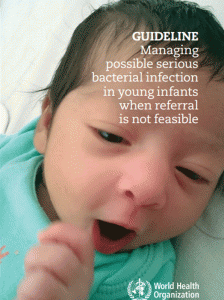
– World Health Organization, 2015. English.
– This Guideline provides recommendations on the use of antibiotics for neonates and young infants (0–59 days old) with PSBI in order to reduce young infant mortality rates and is intended for use in resource-limited settings in situations when families do not accept or cannot access referral. It seeks to provide programmatic guidance on the role of community health workers (CHWs) and home visits in identifying signs of serious infections in neonates and young infants. It also provides clinical guidance on the simplest antibiotic regimens that are both safe and effective for outpatient treatment of clinical severe infections and fast breathing (pneumonia) in children 0–59 days old.
—
Downloads
- Managing possible serious bacterial infection in young infants when referral is not feasible
- French
- WHO/UNICEF Joint Statement on implementing the guideline recommendations
About 1 in 10 newborns develop possible severe bacterial infection during the first month of life and more than 400 000 newborns die from these infections every year.
WHO recommends that infants up to 2 months old with possible severe bacterial infection are treated in hospital with two injectable antibiotics – penicillin or ampicillin plus gentamicin for at least 7 days.
Unfortunately, in resource-limited settings, up to 60% of babies with signs of serious bacterial infection do not receive the recommended inpatient treatment because hospitals are not accessible, acceptable or affordable to families.
New guidance
In cases where the young infant cannot be treated in hospital, WHO has developed new guideline for trained health workers to provide effective outpatient treatment. This guideline will identify young infants who have signs of serious infection to receive treatment even if referral is not possible. The new guideline includes recommendations to treat these infants with a combination of once daily intramuscular gentamicin (for 2 or 7 days) and oral amoxicillin (7 days). Those with fast breathing alone (milder illness) can be treated with oral amoxicillin. For outpatient treatment to be effective, health workers must be trained appropriately and the frontline treatment centres need to be accessible to families and have adequate supplies. Close follow-up is essential for sick young infants under treatment to identify those who worsen or do not improve.
While hospital-based care is the preferred treatment option, these guidelines aim to increase access to treatment and help save lives of babies who cannot get to a hospital.
Latest evidence
In response to WHO Member States’ request for guidance on controversial areas of practice, the new evidence is based on current research evidence and was prepared by an international group of experts from all WHO regions. The guidance updates the relevant sections of Integrated Management of Childhood Illness (IMCI) Chart Booklet (published in 2014).
About the Joint Statement
To support the implementation of the guideline, WHO, UNICEF and other partners developed a Joint Statement (published in February 2017) which summarizes a systematic process for managing sick young infants up to 59 days of age with PSBI in resource-limited settings.
The purpose of the Joint Statement is to facilitate the introduction and implementation of the new guideline as part of national newborn and child health strategies. It targets governments, professional bodies, civil society and development partners working in the area of newborn and child health.
The Joint Statement provides options for the use of simplified antibiotic regimens that are both safe and effective for outpatient treatment of clinical severe infection and fast-breathing pneumonia among young infants weighing at least 1.5 kg. It emphasizes that the standard of care remains referral to hospital for inpatient treatment for sick young infants with any sign of clinical severe infection or critical illness. The simplified antibiotic regimens should only be offered to families when referral is not feasible.